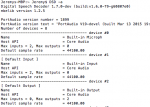jeremyzone
Member
I got DSD 1.7 working on my Macbook Pro running Yosemite. I thought I would write up a quick how to for those who might be interested. There are hints and clues scattered around the web. The best source was Finally got DSD and GQRX working together on OSX : RTLSDR
1. Install Xcode if you don't have it already. This is found in the Mac App store https://itunes.apple.com/us/app/xcode/id497799835?mt=12
2. Install Portaudio (PortAudio - an Open-Source Cross-Platform Audio API)
First download the Portaudio .tgz from their download page PortAudio - an Open-Source Cross-Platform Audio API The one I downloaded was "January 30, 2014, SVN rev 1919". Next extract the file.
Now compile the program using the instructions for Mac PortAudio: Building Portaudio for Mac OS X
(Basically all you have to do is open Terminal, change your directory to the Portaudio folder, then run "./configure && make". Check and see if "libportaudio.dylib" is in the directory "usr/local/lib/". Mine wasn't there so I had to run the "make install" command from the Portaudio folder in order to get it to work!)
3. Install Homebrew (Homebrew)
The homepage explains the simple install process. Basically "ruby -e "$(curl -fsSL https://raw.githubusercontent.com/Homebrew/install/master/install)" "
4. Install DSD
Instructions here https://github.com/szechyjs/dsd/wiki/Installation
Dependency installation
brew install git cmake libsndfile itpp
brew install --HEAD mbelib
DSD install
git clone https://github.com/szechyjs/dsd.git # Something like: git@github.com:USERNAME/dsd.git
cd dsd # Move into source folder
[At this point, copy portaudio.h from the Portaudio folder to the DSD folder before proceeding]
mkdir build # Create build directory
cd build # Move to build directory
cmake .. # Create Makefile for current system
make # Compiles DSD
sudo make install # Installs DSD to the system
5. Run DSD
First check out which audio input and output devices are set up. Type "DSD -a" to see all the options. Figure out which inputs and outputs you want to use. Mine is attached. Since I want to use "Built-in Input" (aka Line In on my computer) I'll use "pa:1" as my input and I want to use "Built-in Output" (aka my laptop's speakers) I'll use "pa:2" as my output. My command to start DSD with these options would end up being "dsd -i pa:1 -o pa:2"
Well that's about all I can think of right now. Hopefully this is helpful to someone or at least saves someone a little bit of time trying to get this set up.
1. Install Xcode if you don't have it already. This is found in the Mac App store https://itunes.apple.com/us/app/xcode/id497799835?mt=12
2. Install Portaudio (PortAudio - an Open-Source Cross-Platform Audio API)
First download the Portaudio .tgz from their download page PortAudio - an Open-Source Cross-Platform Audio API The one I downloaded was "January 30, 2014, SVN rev 1919". Next extract the file.
Now compile the program using the instructions for Mac PortAudio: Building Portaudio for Mac OS X
(Basically all you have to do is open Terminal, change your directory to the Portaudio folder, then run "./configure && make". Check and see if "libportaudio.dylib" is in the directory "usr/local/lib/". Mine wasn't there so I had to run the "make install" command from the Portaudio folder in order to get it to work!)
3. Install Homebrew (Homebrew)
The homepage explains the simple install process. Basically "ruby -e "$(curl -fsSL https://raw.githubusercontent.com/Homebrew/install/master/install)" "
4. Install DSD
Instructions here https://github.com/szechyjs/dsd/wiki/Installation
Dependency installation
brew install git cmake libsndfile itpp
brew install --HEAD mbelib
DSD install
git clone https://github.com/szechyjs/dsd.git # Something like: git@github.com:USERNAME/dsd.git
cd dsd # Move into source folder
[At this point, copy portaudio.h from the Portaudio folder to the DSD folder before proceeding]
mkdir build # Create build directory
cd build # Move to build directory
cmake .. # Create Makefile for current system
make # Compiles DSD
sudo make install # Installs DSD to the system
5. Run DSD
First check out which audio input and output devices are set up. Type "DSD -a" to see all the options. Figure out which inputs and outputs you want to use. Mine is attached. Since I want to use "Built-in Input" (aka Line In on my computer) I'll use "pa:1" as my input and I want to use "Built-in Output" (aka my laptop's speakers) I'll use "pa:2" as my output. My command to start DSD with these options would end up being "dsd -i pa:1 -o pa:2"
Well that's about all I can think of right now. Hopefully this is helpful to someone or at least saves someone a little bit of time trying to get this set up.


